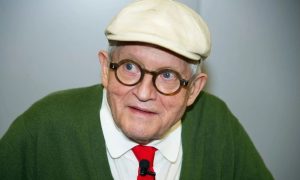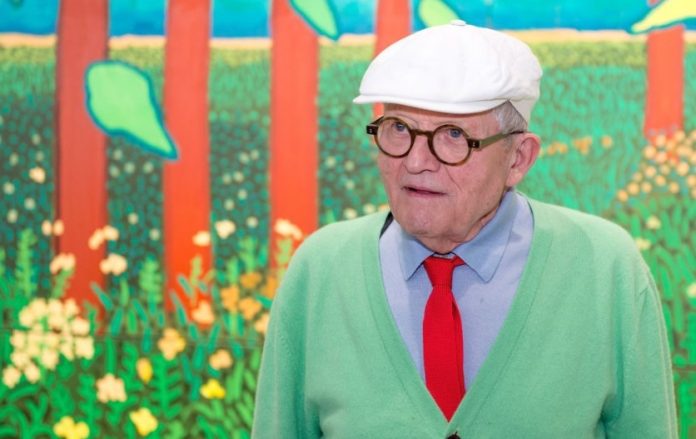Table of Contents
David Hockney remains a towering figure in the world of contemporary art, known for his innovative approach, vivid compositions, and lasting impact across multiple generations.
As one of Britain’s most celebrated living artists, his career spans more than six decades, with work that continues to command attention in galleries and auction houses alike.
This blog explores the financial success behind the creativity—examining the journey, milestones, and market value that have shaped Hockney’s standing in the global art scene.
Who Is David Hockney?

Image – Source
David Hockney is a British artist whose name has become synonymous with bold innovation, vibrant colour, and an unrelenting exploration of visual perception.
Born on 9 July 1937 in Bradford, West Riding of Yorkshire, England, Hockney has carved a lasting legacy as one of the most influential and celebrated figures in modern and contemporary art.
His formal artistic journey began at Bradford School of Art, where he studied from 1953 to 1958.
He later attended the Royal College of Art in London from 1959 to 1962, where he developed his signature style, blending figurative elements with abstraction and emerging as a prominent figure in the burgeoning Pop Art movement.
Over a career spanning more than six decades, Hockney has worked across a wide range of disciplines, including:
- Painting
- Drawing
- Printmaking
- Photography
- iPad and digital drawing
- Stage and set design
His artistic versatility is reflected in a catalogue of iconic works that have resonated with both critics and collectors. Notable pieces include:
- A Bigger Splash (1967)
- Mr and Mrs Clark and Percy (1970–71)
- Portrait of an Artist (Pool with Two Figures) (1972)
- Peter Getting Out of Nick’s Pool (1966)
- American Collectors (Fred and Marcia Weisman) (1968)
- The Blue Guitar (1976–77)
- Bigger Trees Near Warter (2007)
- A Bigger Grand Canyon (1998)
- Garrowby Hill (1998)
- A Bigger Interior with Blue Terrace and Garden (2017)
His works often explore themes of personal identity, human relationships, space, and perception.
Hockney is especially known for his vibrant depictions of Los Angeles swimming pools and for pioneering the use of technology in art, such as his iPad drawings, which became a hallmark of his later works.
In recognition of his extraordinary contributions to the arts, Hockney has received numerous prestigious honours, including:
- John Moores Painting Prize (1967)
- Praemium Imperiale (1989)
- Appointment as Member of the Order of the Companions of Honour (1997)
- Royal Academician
- Order of Merit (2012)
- Honorary Doctorate from Otis College of Art and Design (1985)
Today, David Hockney remains an active and evolving force in the international art world. At 87 years old, he continues to challenge conventions, redefine media, and inspire new generations of artists through his unique vision and relentless creativity.
How Did David Hockney’s Early Life And Education Shape His Career?
Born in Bradford, Yorkshire, in 1937, David Hockney grew up during World War II in a modest, working-class household.
The fourth of five children, he displayed a natural inclination towards art from an early age. His father, an outspoken pacifist, supported his creative pursuits despite financial constraints.
Hockney’s formal education began at Bradford Grammar School and continued at the Bradford School of Art from 1953 to 1957. There, he received traditional training in drawing and painting. His breakthrough came when he was accepted into the Royal College of Art in London in 1959.
Although the institution initially imposed rigid academic requirements, Hockney famously challenged its norms by refusing to submit a written thesis, arguing that his work should speak for itself.
The college eventually relented and awarded him his diploma based on his artistic merit—an early indication of Hockney’s conviction and determination to define success on his own terms.
What Is David Hockney’s Net Worth In 2025?
As of 2025, David Hockney’s net worth is estimated to be approximately $200 million, making him one of the wealthiest living British artists in the world.
This impressive fortune is the result of decades of consistent artistic production, international acclaim, and shrewd management of his brand and commercial rights.
Unlike many artists whose financial value fluctuates based on trends or gallery representation, Hockney’s market has remained remarkably stable and strong.
His artworks have consistently sold for multi-million-dollar figures at major auction houses, and his name commands premium pricing in both private sales and institutional acquisitions.
Factors Contributing to His Wealth
David Hockney’s net worth in 2025 is the culmination of several income streams that go far beyond just painting:
- Art Sales: His paintings regularly fetch high prices, especially since breaking auction records in the late 2010s. The 2018 sale of Portrait of an Artist (Pool with Two Figures) for $90.3 million was a landmark moment that redefined the market value of living artists.
- Prints and Editions: Hockney’s limited edition prints are highly sought after, providing a steady stream of income from collectors who want more accessible pieces of his work.
- Photography and Digital Art: His photo collages and iPad drawings have opened new markets, particularly with collectors interested in digital and experimental media.
- Exhibitions and Royalties: Retrospectives at prestigious institutions like Tate Britain, the Royal Academy of Arts, and Centre Pompidou generate significant revenue. Licensing fees for the use of his images in books, catalogues, merchandise, and media also contribute to his earnings.
- Intellectual Property Rights: As a globally recognised name, Hockney earns from rights usage, reproduction, and brand licensing, which have been carefully managed to ensure financial returns.
High-Value Asset Holdings
In addition to income generated through his creative work, Hockney’s net worth is bolstered by valuable assets, particularly real estate:
- A home in the Hollywood Hills, Los Angeles, purchased during his early years in California
- A rural residence in Bridlington, East Yorkshire, which served as his creative base during his return to Britain in the 2000s
- A house and studio in Normandy, France, where he now spends most of his time creating iPad landscapes and digital compositions
These properties, located in some of the most desirable regions in the world, are themselves worth several million pounds collectively and continue to appreciate in value.
Market Influence and Longevity
One of the most compelling aspects of Hockney’s financial success is the longevity of his career. While many artists fade from commercial view after a certain age or artistic period, Hockney has continued to evolve.
From his 1960s Pop Art roots to his 21st-century iPad works, his art remains fresh and relevant, sustaining both collector interest and institutional demand.
Additionally, Hockney’s continued productivity at the age of 87 demonstrates not only an enduring creative spirit but also a business-savvy understanding of how to adapt to the changing landscape of the art world.
His ability to engage with digital platforms and emerging media has attracted a new generation of collectors and art enthusiasts, extending his market influence well into the digital age.
What Are David Hockney’s Most Expensive Artworks?

Image – Source
David Hockney’s works have consistently commanded high prices at major auctions, particularly over the past two decades.
The record-breaking sale of Portrait of an Artist (Pool with Two Figures) in 2018 for $90.3 million at Christie’s marked a milestone in his career, setting the highest price ever paid for a painting by a living artist at the time.
Other notable auction highlights include:
- Henry Geldzahler and Christopher Scott (1969) – $49.5 million
- The Splash (1966) – $29.8 million
- Pacific Coast Highway and Santa Monica (1990) – $28.5 million
These figures demonstrate not only Hockney’s artistic acclaim but also the value placed on his work within the investment-focused contemporary art market.
How Does David Hockney Earn His Money Beyond Painting?
While the sale of paintings forms the foundation of Hockney’s financial success, his income streams are diverse. He is an accomplished printmaker, with limited edition prints fetching significant sums. Photography, especially his “joiners,” has also contributed to his earnings.
Additionally, Hockney has worked extensively in stage design, creating sets and costumes for operas and ballets in London, New York, and other cultural hubs. His collaborations with institutions like the Royal Opera House have been both critically and commercially successful.
Revenue sources outside traditional art sales include:
- Licensing of artwork for books, posters, and merchandise
- Royalties from exhibitions and documentaries
- Speaking engagements and public appearances
Hockney’s business acumen and management of his brand have played a crucial role in ensuring long-term financial stability.
What Inspired Hockney’s Famous Swimming Pool Paintings?
Hockney’s first trip to Los Angeles in 1964 had a profound impact on his art. Captivated by the city’s architecture, climate, and lifestyle, he began incorporating these elements into his work. Swimming pools, with their clean lines and shimmering surfaces, quickly became a recurring theme.
The swimming pool series is among his most iconic contributions to contemporary art. Works such as A Bigger Splash (1967) and Portrait of an Artist (Pool with Two Figures) (1972) reflect his fascination with light, water, and the California aesthetic.
These pieces also demonstrate his technical skill in capturing movement and atmosphere while maintaining a carefully structured composition.
Key elements that defined this period of work include:
- Vivid use of blues and greens to convey depth and reflection
- Geometric clarity in pool shapes contrasted with organic splash patterns
- Symbolic representations of leisure, wealth, and isolation
This body of work played a significant role in establishing Hockney’s identity as a globally recognised artist.
How Do Personal Relationships Influence David Hockney’s Portraits?

Image – Source
Portraiture has always been central to Hockney’s artistic output, often serving as a reflection of his personal life and emotional connections.
He has painted intimate depictions of family members, friends, and lovers, capturing not just physical likenesses but emotional states and psychological depth.
His double portraits from the 1970s, including Mr and Mrs Clark and Percy and Christopher Isherwood and Don Bachardy, are prime examples of how he conveys relational dynamics through composition and expression. These works often explore themes such as love, companionship, tension, and domesticity.
Being openly gay from a young age, Hockney was among the few public figures in mid-20th century Britain to express his sexuality through art. His portraits of male lovers, created during a time when homosexuality was still illegal in the UK, were both brave and groundbreaking.
His work provides a rare visual narrative of gay life and relationships during that era, helping to pave the way for broader representation in the arts.
What Role Has Technology Played In Hockney’s Creative Evolution?
David Hockney has shown a remarkable willingness to adapt to and experiment with new technologies throughout his career. In the early 1980s, he introduced his “joiners,” or photographic collages made from Polaroids and 35mm prints.
These images were assembled to depict subjects from multiple angles and moments in time, challenging traditional ideas of perspective and narrative in photography.
In the 2000s, Hockney began working with digital tools, creating artworks using the Brushes app on his iPhone and iPad. The immediacy of digital media allowed him to sketch and paint wherever he was, adding a spontaneous dimension to his creative process.
Highlights of his digital evolution include:
- Thousands of iPad drawings capturing Yorkshire and Normandy landscapes
- Real-time sharing of digital art with followers and gallery audiences
- Multi-canvas digital installations, including those featured in A Bigger Picture exhibition at the Royal Academy
These innovations not only reaffirmed his relevance in the digital age but also expanded the definition of fine art to include digital and interactive elements.
How Has Hockney’s Legacy Impacted The Contemporary Art Market?
David Hockney has significantly influenced both the artistic and commercial dimensions of the modern art world. His embrace of digital mediums helped legitimatise new forms of art, such as digital drawing and tablet-based painting, in galleries and auction houses.
In market terms, his record-breaking auction sales have pushed boundaries and set new standards for living artists. The success of his work has helped position contemporary British art as a formidable force in the global market.
Broader impacts of his legacy include:
- Encouraging more inclusive narratives around identity and sexuality
- Inspiring new generations to blend traditional and digital techniques
- Establishing the artist as a financially independent and culturally relevant brand
His long-term influence is seen not only in the value of his artworks but in how art institutions curate exhibitions, promote artists, and evaluate innovation.
What Assets And Properties Does David Hockney Own?

Image – Source
Hockney’s property portfolio includes several residences across the UK, the US, and France. These homes serve dual purposes—as living spaces and as artistic retreats.
Key properties include:
- Los Angeles: A long-time home in the Hollywood Hills, close to the cultural and artistic life that inspired many of his works
- East Yorkshire: A rural property in Bridlington, used primarily during his landscape-focused phase in the 2000s
- Normandy: A home and studio space where he currently spends most of his time, creating digital artworks of the surrounding countryside
In addition to these homes, Hockney owns an extensive personal art collection and a wide range of creative tools and archives. His properties, like his art, reflect a commitment to environment, comfort, and artistic inspiration.
Why Is David Hockney Considered One Of The Richest British Artists?
David Hockney stands among the wealthiest British artists not only due to the value of his work but also because of his consistent presence in the international art scene. While many artists achieve critical acclaim without financial success, Hockney has managed to excel in both domains.
Reasons for his financial success include:
- Strategic management of his brand and intellectual property
- High-yield investments in real estate and exhibitions
- Global appeal across both high-end collectors and general audiences
His ability to adapt artistically and commercially over six decades places him in a league of his own. As a result, Hockney has become not just an artist but a cultural institution in his own right.
Conclusion
David Hockney’s remarkable journey from a working-class upbringing in Bradford to becoming a globally celebrated artist is a testament to his talent, vision, and adaptability.
His artistic achievements are matched by his commercial success, making him a significant figure not just in cultural circles but also in the art market.
As his legacy continues to grow, so does his influence—cementing his position as one of the most important and financially successful British artists of the modern era.
FAQs
What mediums does David Hockney work with today?
David Hockney continues to use a wide variety of mediums including digital drawing on the iPad, acrylic painting, photography, and printmaking. He adapts new tools as they emerge while retaining a focus on traditional visual elements like light and space.
Has Hockney received any major honours or awards?
Yes, Hockney has received numerous accolades, including the Order of Merit and being appointed a Companion of Honour. He has also been the subject of major retrospectives at leading art institutions.
What makes Hockney’s style unique?
Hockney’s work is recognised for its vibrant colours, playful compositions, and exploration of perspective. His ability to merge personal storytelling with technical mastery sets his style apart.
Is David Hockney’s art a good investment?
Given his auction performance and consistent demand, many art collectors and investors view Hockney’s work as a solid long-term investment in the contemporary art market.
How has Hockney influenced younger artists?
Many younger artists cite Hockney as a major influence due to his fearless experimentation and embrace of digital technology. His impact is visible in the integration of tech and traditional art forms.
Where can you see David Hockney’s work in the UK?
His works are displayed in institutions such as the Tate Britain, the Royal Academy of Arts, and regional galleries like Salts Mill in Yorkshire.
How did Hockney respond to changes in the art world during the digital era?
He embraced technology early, using devices like the iPhone and iPad for sketching. This openness helped him maintain relevance and connect with newer generations of artists and audiences.
Featured Image – Source


